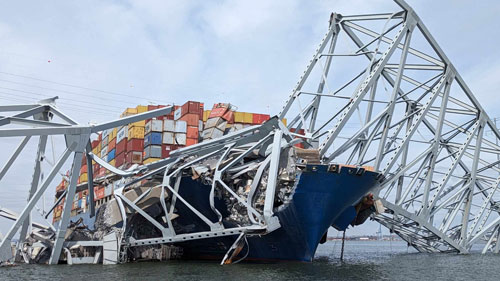
Credit: U.S. Army Corps of Engineers, Baltimore District
On March 31, 2024, Unified Command made an important announcement concerning navigation through Fort McHenry Channel into and out of the Port of Baltimore.
The Captain of the Port (COTP) is preparing to establish a temporary alternate channel on the northeast side of the main channel in the vicinity of the Francis Scott Key Bridge for commercially essential vessels.
This action is part of a phased approach to opening the main channel. The temporary channel will be marked with government lighted aids to navigation and will have a controlling depth of 11 feet, a 264-foot horizontal clearance, and vertical clearance 96 feet.
Aids to Navigation personnel and assets operating under the Unified Command dropped buoys in the water in the vicinity of the Francis Scott Key Bridge, Sunday, March 31, 2024. (Courtesy video by Key Bridge Response Unified Command)
The tugboat Crystal Coast pushes a fuel barge through the temporary alternate channel created by the Key Bridge Response Unified Command, near the Key Bridge incident, in Baltimore, Maryland, April 1, 2024. The Crystal Coast is the first vessel to use the channel since the bridge collapsed into the federal waterway on March 26th. (U.S. Coast Guard video by Petty Officer 2nd Class Taylor Bacon)
On April 1st, 2024, the tugboat Crystal Coast pushing a fuel barge, transited the temporary alternate channel created by the Key Bridge Response Unified Command. Crystal Coast was the first vessel to use the channel since the bridge collapsed into the federal waterway on Tuesday March 26th.
The barge is used to supply jet fuel to the Department of Defense (DOD) and was transiting to Dover Air Force Base.
The Captain of the Port (COPT) established the temporary alternate channel near Sollers Point for commercially-essential vessels. The temporary channel is on the northeast side of the main ship channel in the vicinity of the Francis Scott Key Bridge. This action is part of a phased approach to opening the main federal channel.
This new temporary channel is marked with government-lighted aids to navigation. It will be limited for transit at the discretion of the COTP and during daylight hours only. This temporary channel has a controlling depth of 11 feet, a 264-foot horizontal clearance, and vertical clearance of 95 feet.
On April 2, 2024, the Captain of the Port (COTP) established a second temporary alternate channel on the southwest side of the main channel near Hawkins Point in the vicinity of the Francis Scott Key Bridge for commercially essential vessels.
This action is part of a phased approach to opening the main channel. The second temporary channel is marked with government lighted aids to navigation and will be limited to transit at the discretion of the COTP and during daylight hours only. It has a controlling depth of 14 feet, a 280-foot horizontal clearance, and a vertical clearance of 124 feet.
On April 4th, USACE Baltimore District announced that, after detailed studies and engineering assessments by local, state and federal organizations, in collaboration with industry partners, USACE expects to open a limited access channel 280 feet wide and 35 feet deep, to the Port of Baltimore by the end of April.
The new channel would support one-way traffic in and out of the Port of Baltimore for barge container service and some roll on/roll off vessels that move automobiles and farm equipment to and from the port.
The current 2,000-yard safety zone around the Francis Scott Key Bridge remains in effect and is intended to protect personnel, vessels, and the marine environment. No vessel or person will be permitted to enter the safety zone without obtaining permission from the COTP or a designated representative.
The COTP will issue a Broadcast Notice to Mariners (BNM) via VHF-FM marine channel 16. Mariners are requested to monitor the VHF channel 16 for the latest information.
Members of the public may not enter the safety zone unless authorized by the COTP or designated representative. Those in the safety zone must comply with all lawful orders or directions given to them by the COTP or designated representative.
A Debris Reporting Hotline has been established. If the public encounters any debris from the incident, please contact +1 (410) 205-6625
The Key Bridge Response 2024 Unified Command includes the:
U.S. Coast Guard
U.S. Army Corps of Engineers
Maryland Department of the Environment
Maryland Transportation Authority
Maryland State Police
Witt O’Brien’s representing Synergy Marine
A website with incident response information can be found at the following URL:
https://www.keybridgeresponse2024.com
For updated information on the status of the maritime transportation system visit the U.S. Coast Guard Sector Maryland – National Capital Region Homeport page: https://homeport.uscg.mil/port-directory/maryland-ncr
Resources are available for businesses and individuals impacted by the Port closure:
Benefit Line for Port of Baltimore Workers: +1 (667) 930-5989
Disaster Loan Assistance: https://lending.sba.gov
Related Information
Port of Baltimore FSK Bridge Wreckage Removal Efforts
M/V Dali Collision – Francis Scott Key Bridge Collapse NTSB Investigation
Leave a Reply
You must be logged in to post a comment.